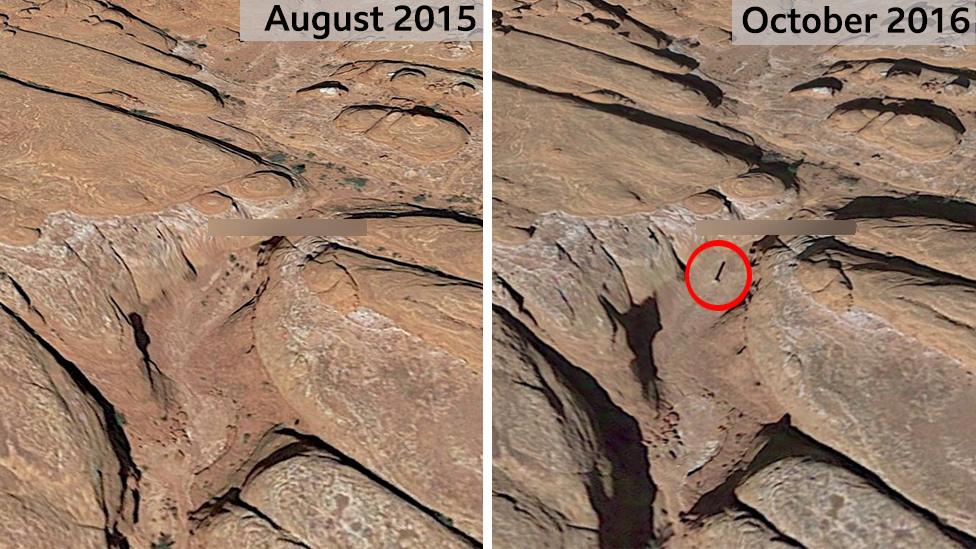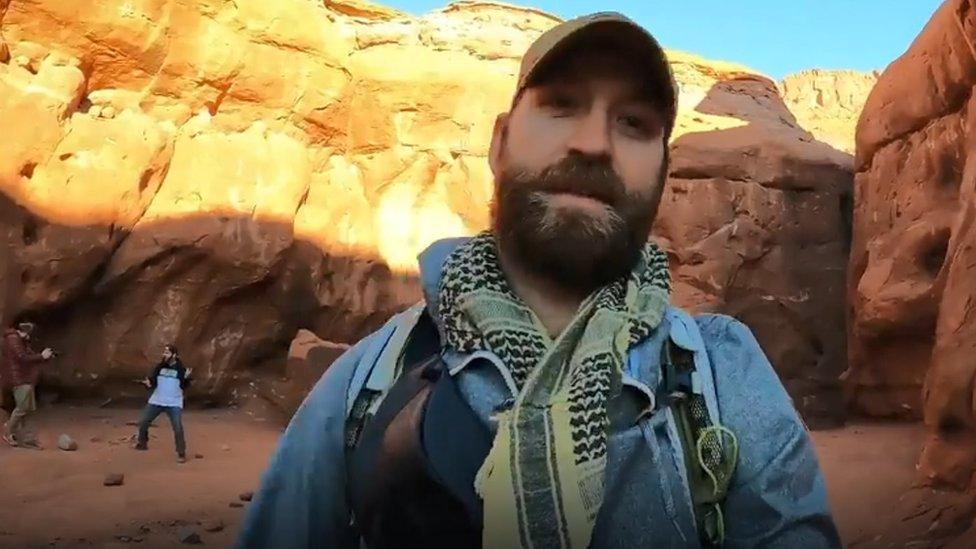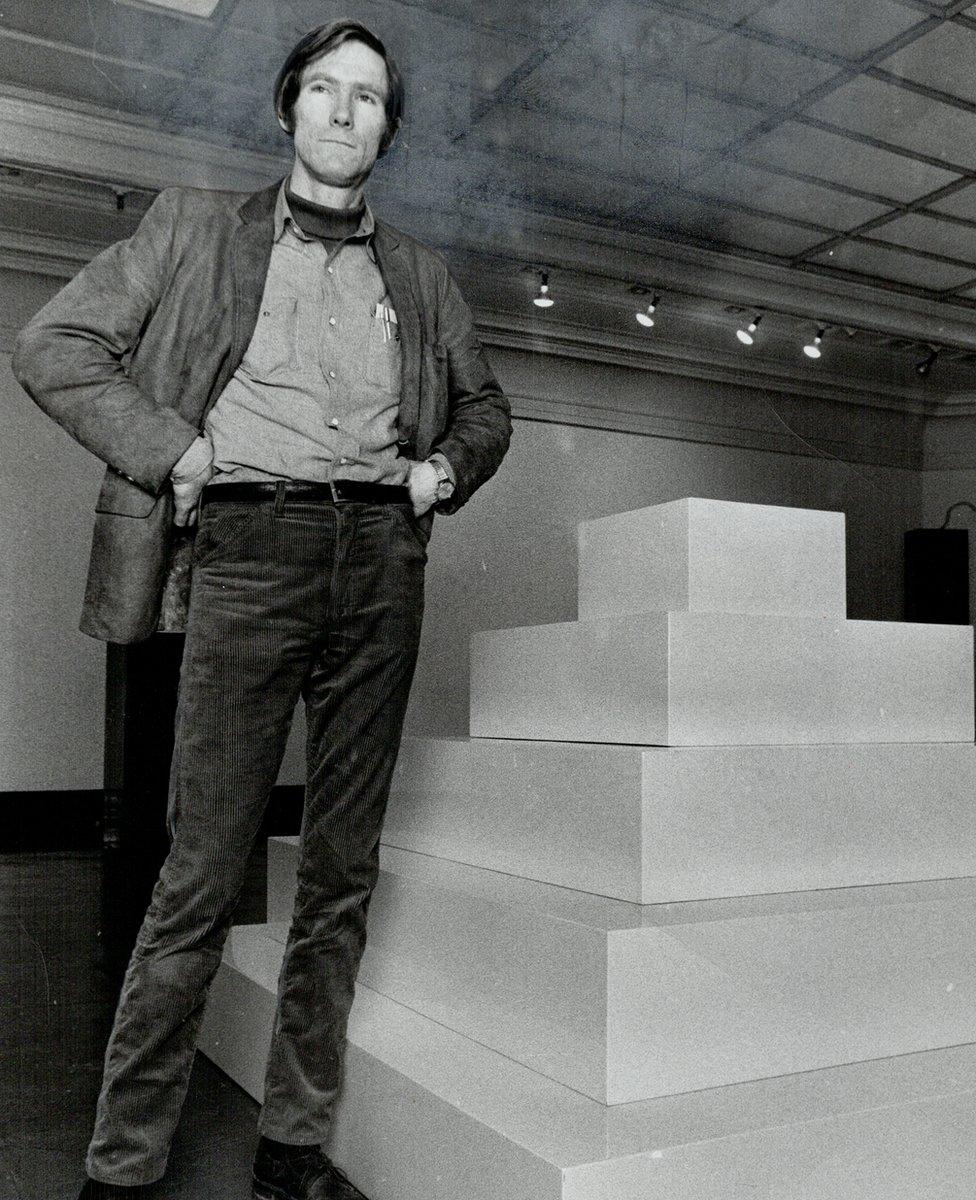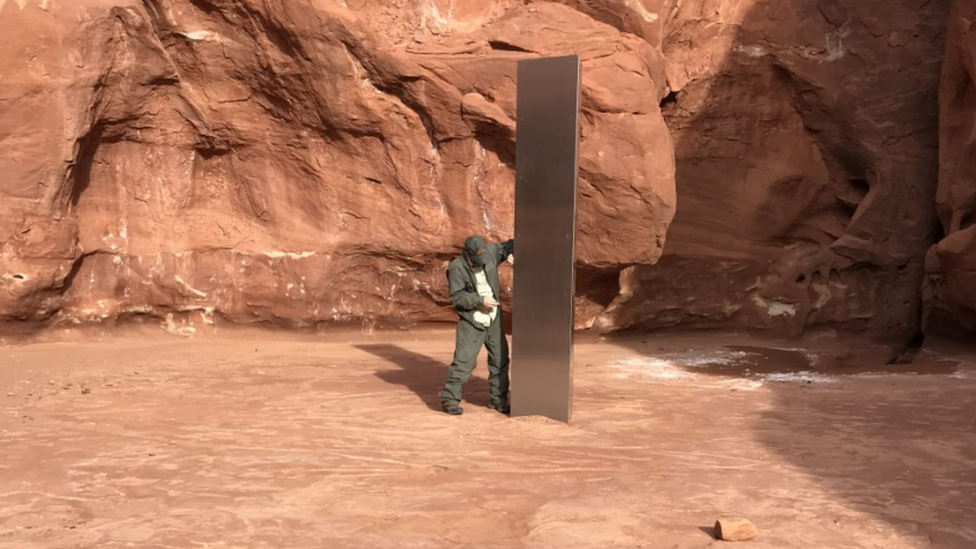Utah monolith: Internet sleuths got there, but its origins are still a mystery
- Published

David Surber saw the apparent co-ordinates online and decided he had to be the first one there
It took just 48 hours for the first person to get there.
When officials in Utah on Monday revealed they had found a shimmering, metal structure deep in the Red Rock desert, they refused to say exactly where.
They hoped that would be enough to deter amateur adventurers from setting off to find it, risking getting dangerously lost in the process.
But there was little chance that people would abide by this advice. By Wednesday, pictures were emerging on Instagram of people triumphantly posing with the monolith, eager to show the world that they had got there first - even if the wider mystery of why it is there remains unsolved.
They were aided by internet sleuths who had quickly geo-located the structure on Google Earth and posted the co-ordinates online.
"I decided to go there first because I was drawn to the fact that this object had been there for five years, hidden in nature," said David Surber, a 33-year-old former US Army infantry officer who drove six hours through the night after finding a Reddit post claiming to have found the exact location.
State wildlife officials originally spotted the object on 18 November while conducting a helicopter flyover of the remote, Mars-like terrain to count big horn sheep. The Reddit user who posted the co-ordinates, Tim Slane, said he had tracked the flight path of the helicopter until it went off-radar - a sign it might have landed.
The crew found the unusual object while conducting a count of big horn sheep in the area
At this point, he scanned the map for the exact features of the terrain seen in official photos and videos, before zeroing in on a canyon that appeared to fit the bill. There, a distinct shadow - long and narrow - could be seen. It's not visible in historic satellite imagery from 2015, but appears in October 2016 when scrubland in the vicinity also appears to have been cleared.
"I knew that once the location became public knowledge that people would visit the area," said Mr Slane. "I have received some angry messages for my revealing of the location. If I had not found it, someone else would likely have found it soon enough."

David, who lives in Utah, swung into action - telling the Reddit community of thousands following the mystery that he was heading there. On the way, he was bombarded with hundreds of messages and requests. They included things like: "Bring a magnet in case there is a secret door!"
He arrived in the early hours when it was still pitch black. At first he was alone, marvelling not just at the monolith but at shooting stars. Then others started to turn up, also having found the coordinates online. He was thrilled to report his find back to Reddit.
"It was a good escape from all the negativity we've experienced in 2020."

But two questions remain: who put the structure there, and why?
While many have suggested - some sincerely, most in jest - that the monolith was planted by extra-terrestrial visitors, the prevailing theory is that it is an as-yet-unclaimed conceptual artwork.
Initially experts suggested it may have been an unknown work by the late John McCracken, who is known for his "plank" sculptures. His gallerist David Zwirner initially confirmed this, but the gallery later retracted that statement, saying they believed it was another artist paying homage instead. McCracken died in 2011.
Some online then narrowed in on another artist, Petecia Le Fawnhawk, who installs totemic sculptures in secret desert locations and, crucially, used to live and work in Utah.
But she told the online art magazine Artnet that while she "did have the thought to plant secret monuments in the desert", she "cannot claim this one". So the creator of the totem remains a mystery for now.

John McCracken - the late artist many first pointed to when the news broke
It's not uncommon for artworks to be installed in remote locations - either as sculptures, or as "land art", a form of art that makes use of its natural surroundings. For many of these pieces, the journey to get there is as much a part of the artwork as the actual installation.
One of the most famous examples of this is Walter de Maria's The Lightning Field, external. Its exact location is a tightly-guarded secret - all that is known is that it's in the high desert of western New Mexico, although small groups of visitors can book to be taken there. Another is the temporary land art of Martin Hill and Philippa Jones, such as Synergy, external - a piece that was installed in Lake Wanaka, New Zealand, in 2009.

Andy Merritt, a British artist who creates outdoor public sculptures as part of the duo, Something and Son, said that when he saw stories about the Utah monolith, he thought it was "either an artist, or a rich person who's got fantasies around 2001: A Space Odyssey".
"There are so many artists who do stuff in unusual places, especially in America," said Merritt, who plans to "fossilise" a suburban house in Milton Keynes, north of London, next spring by pouring a mixture into the interior and making a cast of its negative space. "Even in my own work, we always want to be doing things in unusual places.
"If you took what they did in the middle of Utah - presuming it is an artist - and put it in another location, like a public square, it would be a lot less interesting. It's the landscape itself that really is the talking point."
Video from the dozens - perhaps even hundreds of people - who have already visited the location suggest a professional job. Three large sheets of what appears to be stainless steel were riveted together, with the inside left hollow. Whoever put it there used heavy-duty tools to cut into the bedrock and embed the structure.
"One person alone could not have done it so there is a group of people who have some knowledge of it somewhere," said Wendy Wischer of the University of Utah's School of Fine Art. "Most artists want some recognition for what they are doing but this seems to include a level of humour and mystery as part of the intention."
David Surber, reflecting on his trip to the monolith, admitted he at first hoped its origins would be "otherworldly".
"Yet deep down inside you know it was most likely just a very patient artist or Space Odyssey 2001 fan."
Like Andy Merritt, he's referring to the imposing black monoliths that play an important, but mysterious, role in the 1968 Stanley Kubrick science fiction film 2001: A Space Odyssey.
In an interview on Thursday, a public information officer at the Utah Department of Public Safety told the BBC that while they don't encourage anyone to travel to the monolith because it could be dangerous, they can't do anything to stop them as the area is public land. No decision has been made to remove it.
"The genie is out of the bottle," said Cpl Andrew Battenfield, when told people had been turning up and posting pictures on social media. "It's a free country."
- Published24 November 2020
